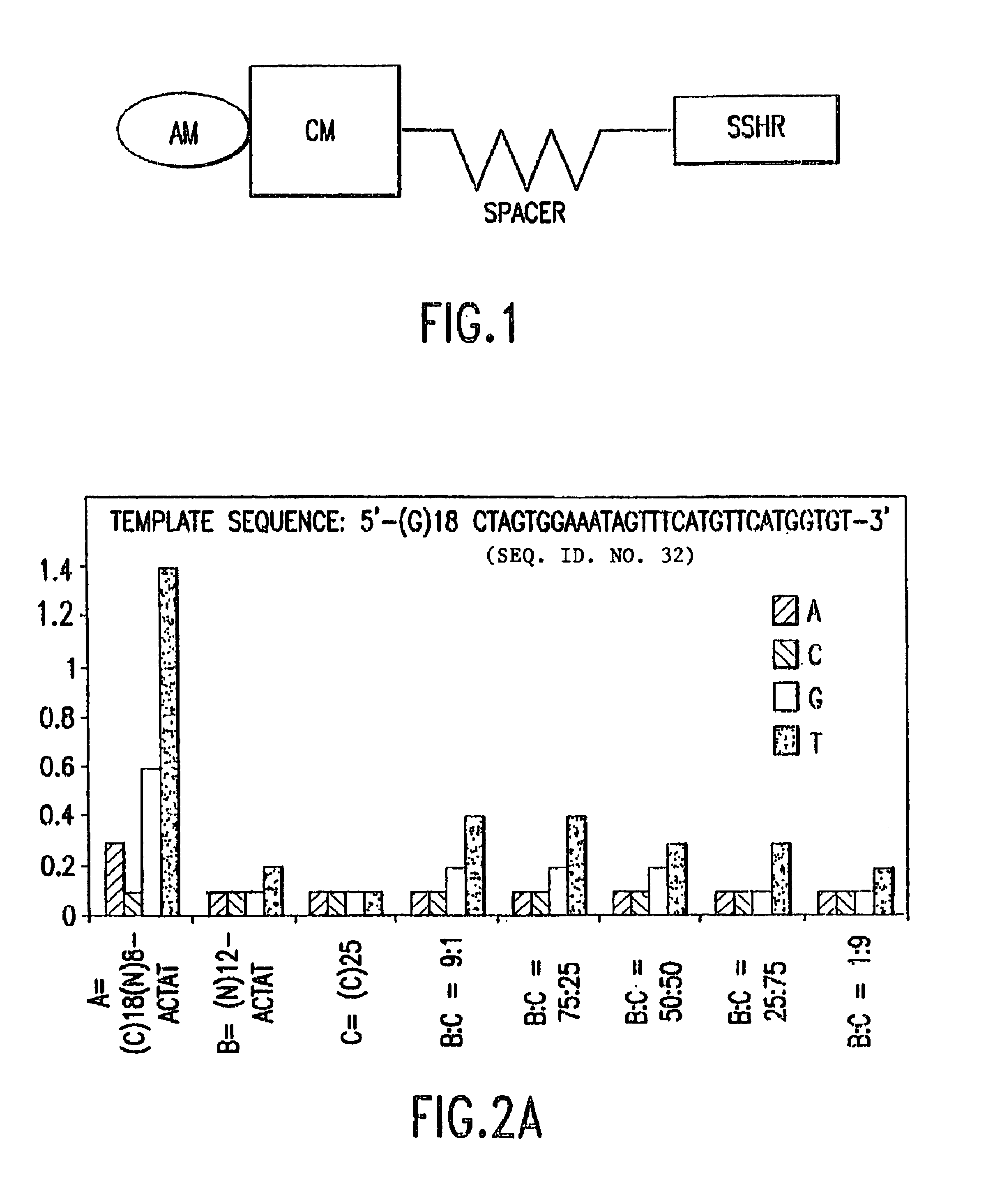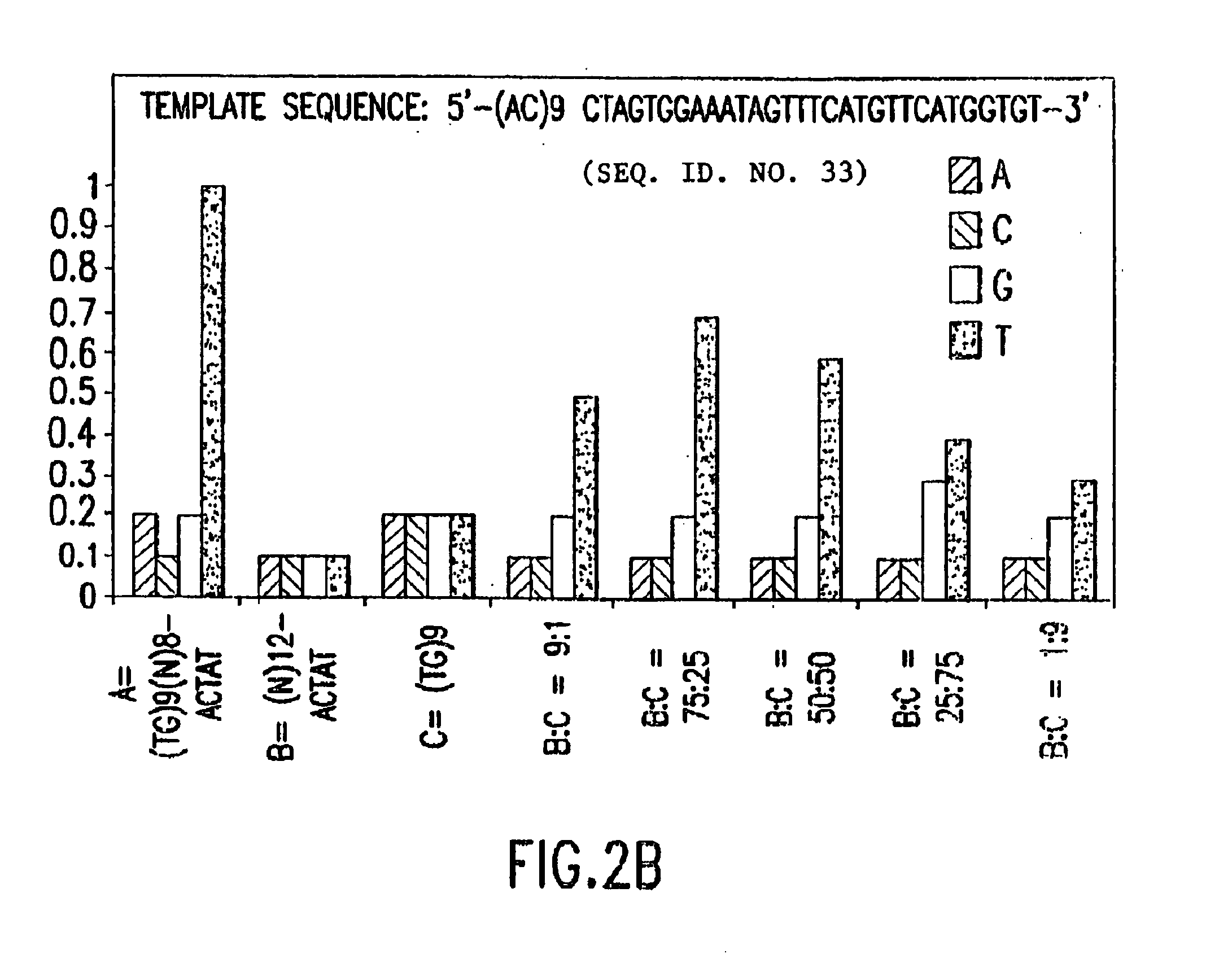De novo or “universal” sequencing array
a sequencing array and node technology, applied in the field of nucleic acid sequencing reagents, can solve the problems of inability to form a phosphodiester bond with a subsequent nucleoside triphosphate, requires meticulous experimental techniques, and is extremely laborious
- Summary
- Abstract
- Description
- Claims
- Application Information
AI Technical Summary
Benefits of technology
Problems solved by technology
Method used
Image
Examples
example 1
Coupling of the Sequencing Reagent to the Solid Support by Means of a Disulfide Exchange Reaction
[0107]The general chemistry of the thiol-disulfide exchange reaction has been previously described by Ryden, L. et al., herein incorporated by reference. (In: Jansosn, J. et al., eds. Protein Purification: Principles, High Resolution Methods, and Application, VHC Publishers, Inc., New York, N.Y. (1989)).
R1SSR1+RSH→R1SH+R1SSR
R1SSR+RSH→R1SH+RSSR
[0108]Attachment of the 5′- or 3′-disulfide modified oligonucleotide is obtained by a two step process of silane treatment and oligonucleotide binding. Initially, the glass slides are etched overnight in 25% aqueous ammonium hydroxide and then rinsed sequentially with milliQ water and 95% ethanol. The glass slides are then treated for 30 minutes with 3-mercapto-proyl-trimethoxysilane (MPTS) in an acidic buffer of aqueous ethanol (95% ethanol, pH 4.5). The slides are then cured for at least 48 hours under a dry inert gas, such as Ar2 or N2.
[0109]The ...
example 2
Coupling of the Sequencing Reagent to the Solid Support by Means of a Disulfide Formation Reaction
[0111]In a second embodiment, the coupling reaction is accomplished by means of a disulfide formation reaction. This method is used to attach sequencing reagents to a glass slide by coupling 5′-sulfhydyl modified sequencing reagents to sulfhydryl groups of the mercaptosilane coated surface.
[0112]The glass slides are initially coated with mercaptosilane to introduce sulfhydyl groups onto the surface following the protocol detailed above. 5′-sulfhydryl modified sequencing reagents are obtained by treating the disulfide modified sequencing reagent with dithiolthreitol (0.04M in 0.17M phosphate buffer, pH 8.0) at room temperature overnight. Then, the 5′-sulfhydryl modified sequencing reagents (at a concentration greater than 2 μm) are exposed to the mercaptosilane surface in a carbonate buffer (500 mM, pH 9.0) for 2 hours at room temperature. The formation of disulfide bonds between the sur...
example 3
Passive Adsorption of the Sequencing Reagent to the Solid Support
[0113]Several methods can be used to non-specifically adsorb sequencing reagents to solid supports such as 96-well polystyrene plates. One such method involves the dilution of the sequencing reagent to a 200 nM concentration in a 50 mM solution of octyl-dimethylamine-HCl (ODA). This solution is then incubated (50 μl / well) in polystyrene 96-well plates. After overnight incubation at 37° C., the plate is washed with 10 mM Tris pH 7.5 / 150 mM NaCl / 0.05% polysorbitan 20 (Tween-20) (herein referred to as “TNTw”) to remove excess primer. This method can also work with other cationic agents (instead of ODA) such as cetyl-trimethylammonium chloride and salts such as NaCl.
PUM
| Property | Measurement | Unit |
|---|---|---|
| Length | aaaaa | aaaaa |
| Nucleic acid sequence | aaaaa | aaaaa |
Abstract
Description
Claims
Application Information
 Login to View More
Login to View More - R&D
- Intellectual Property
- Life Sciences
- Materials
- Tech Scout
- Unparalleled Data Quality
- Higher Quality Content
- 60% Fewer Hallucinations
Browse by: Latest US Patents, China's latest patents, Technical Efficacy Thesaurus, Application Domain, Technology Topic, Popular Technical Reports.
© 2025 PatSnap. All rights reserved.Legal|Privacy policy|Modern Slavery Act Transparency Statement|Sitemap|About US| Contact US: help@patsnap.com


